Detection of Typical Defects in Silicon Photovoltaic Modules and Application for Plants with Distributed MPPT Configuration
Abstract
1. Introduction
2. Tests for Identification of Defects in PV Generators
2.1. Infrared Thermographic and Electroluminescence Imaging
- The El test cannot be performed during PV operation;
- In cases of optical degradation, glass breakage, or delamination, the EL test is less efficient;
- As in case of IRT, the power loss of a defective module cannot be quantified.
2.2. I-V Curve Characterization
- A lower ISC than the expected value may represent discoloration of encapsulation, glass corrosion, etc.;
- A stepped-shaped I-V curve usually represents the current mismatch that may be caused by damaged cells, gathering of soil over the surface, or partial shading;
- A decrease in VOC shows the light induced degradation, the potential induced degradation, or shorted bypass diode;
- Increased slope near the ISC can be due to the formation of shunt paths in the PV cells;
- A lower value of the slope of the characteristic curve near the VOC usually suggests an increase of interconnection resistance, oxidization in the junction box, or damaged interconnecting ribbons.
3. Review of Common Defects in Silicon PV Modules
3.1. Ethylene Vinyl Acetate (EVA) Failures
3.2. Cell Cracks
- Mode A cracks do not lead to inactive cell parts. However, ageing and exposure to environmental stresses in the field may cause the complete electrical separation of cell parts.
- Mode B cracks represent cracks producing a minimal effect on the electrical efficiency of the module.
- In mode C cracks, the cracks lead to inactive cell parts. These have a severe effect on the electrical properties of the module, leading to the formation of hotspots [37].
3.3. Hot Spot Heating
3.4. Disconnected Cells and Faulty String-Ribbon Interconnection
3.5. Potential Induced Degradation
- In path P1, the current flows along the surface of the glass cover and via the bulk of the glass and the encapsulant;
- Through path P2, the current flows through the bulk of the glass cover and that of the encapsulant;
- From the frame along the junction of the front glass cover and through the encapsulant (path P3);
- From the frame through the encapsulant towards the negatively biased PV cell, shown as P4;
- Along the interface of the encapsulant and the backsheet and through the encapsulant (P5); and
- In P6, the leakage current flows from the frame along the backsheet and through it and the encapsulant.
3.6. Defective Bypass Diodes
- When a PV module of a string is shaded (or a few cells of a single module), the bypassed diodes of the shaded module start to conduct (partial shading). Due to conduction of current, their temperature increases and can easily exceed the maximum temperature for the materials of the PV modules (≈ 85 °C). The regular operation of the bypass diodes causes spot heating in the PV modules [63].
- Bypass diodes undergo thermal runaway in the event of cyclic transition from forward to reverse bias [64]. This thermal runaway takes place when the power dissipation in the reverse biased diode is greater than the cooling capacity of the junction box.
- Shading and fluctuations in irradiance can also lead to regular current cycling via the bypass diodes. Self-heating leads to thermal cycling.
4. Finding the Values of Parameters for Fault Diagnosis from On-Site Measurements
4.1. Current Methodologies for Determination of Shunt and Series Resistances
4.2. The proposed Alternative Methodology for the Determination of Shunt and Series Resistances
- Take the operating point of the PV generator close to ISC. From the slope of the I-V curve close to ISC, estimate the value of ISC (or Iph).
- Take the operating point of the PV generator close to VOC and estimate the value VOC from the slope of the I-V curve (for example points A and E in Figure 13).
- Calculate the value of Rs by using Equation (21)
- Operate the PV generator at the MPP (or close to it) and use Equation (22) to find the value of Rsh.
5. Maximum Power Point Tracking for Fault Diagnosis
5.1. Comparison of Maximum Power Point Tracking Architectures
- Centralized MPPT architecture (the oldest one).
- String inverter scheme.
- Module integrated MPPT scheme.
- SubModule Integrated (SMI) MPPTs (the newest one).
- The SMI MPPT architecture decouples module from PV strings and in this way, the MPP control of each SubModule (SM) is possible.
- Online monitoring and diagnosis of the PV modules is easy. As shown later in this paper, it is possible to check the existence of a fault by making small adjustment in the MPPT algorithm.
- Some inverters are able to communicate with the PV modules by exchanging the performance data [67]. In this way, the extent and the physical location of a fault is easily known.
- In reference [84] it is predicted that, during the 30 years of operation, the SMI architecture yields more power in different installations like PV plants on land, rooftop, façade, and electric vehicles. In references [85,86], it is reported that this configuration gives 20% more energy as compared to other types of DMPPTs.
- The hardware for DMPPTs can be installed in the junction box of the PV module and a single microcontroller performs the MPP tracking of all the three submodules [85]. Even though the arrangement in [80] does not use a current sensor and measures the voltage drop across the inductor of the buck converter for estimating the current, it is possible to use an accurate Hall Effect based current sensor for accurate measurements. The cost of these sensors has decreased in recent years and accurate sensing of current is possible without any substantial increase in the system cost.
- In references [76,77,78,79,80], researches investigate the possibility of avoiding the installation of bypass and the reverse blocking diodes. According to [87], the insertion of the blocking diodes against reverse currents can be avoided with crystalline silicon technology, provided that the short circuit fault inside the submodule is not possible thanks to the double insulation typical of commercial PV devices.
- The PV modules in the string and centralized inverter schemes are subject to high voltage stresses which make them vulnerable to PIDs. In the SMI MPPTs, every submodule operates independently at a voltage less than 20 V. This eliminates the risk of PIDs.
- The MPP tracking is quite easy as there is always a single peak on the P-V curve of the SM. In this way, a conventional MPPT scheme can be used to track the peak. Through small modification in the algorithm, it is also possible to improve the tracking speed of the conventional MPPT and to obtain the diagnostics information.
5.2. Application of Submodule Integrated MPPT with Fault Diagnosis
- When irradiance G = 500 W/m2, and cell temperature T = 298 K;
- When G = 700 W/m2 and T = 348 K.
6. Conclusions
Author Contributions
Funding
Conflicts of Interest
Nomenclature
| a | diode ideality factor |
| I | PV cell current (A) |
| G | irradiance on the cell surface (W/m2) |
| Gn | nominal irradiance (1000 W/m2) |
| IMPP | maximum power point current (A) |
| I0 | saturation current (A) |
| Iph | photo-generated current (A) |
| ISC | short circuit current (A) |
| Iscn | nominal short circuit current (A) |
| k | Boltzmann constant (J/K) |
| KI | thermal coefficients of current (A/°C) |
| KV | thermal coefficients of voltage (V/°C) |
| ns | number of cells in series |
| NΔRs | normalized increase in the series resistance |
| q | electron charge (C) |
| Rs | series resistance (Ω) |
| Rs,n | series resistance of cells (Ω) under nominal conditions |
| RS0 | series resistance close to Voc (Ω) |
| Rsh | shunt resistance (Ω) |
| Rsh0 | negative reciprocal of the slope of the I-V curve close to ISC (Ω) |
| T | temperature of the module (°C) |
| Ta | air temperature (°C) |
| Tn | nominal temperature (°C) |
| V | PV cell voltage (V) |
| VMPP | maximum power point voltage (V) |
| VOC | open circuit voltage (V) |
| VOCn | nominal voltage (V) |
| Vt | thermal voltage at STC temperature (≈25.7 mV) |
References
- Rashid, K.; Safdarnejad, S.M.; Ellingwood, K.; Powell, K.M. Techno-economic evaluation of different hybridization schemes for a solar thermal/gas power plant. Energy 2019, 181, 91–106. [Google Scholar] [CrossRef]
- Rashid, K.; Safdarnejad, S.M.; Powell, K.M. Dynamic simulation, control, and performance evaluation of a synergistic solar and natural gas hybrid power plant. Energy Convers. Manag. 2019, 179, 270–285. [Google Scholar] [CrossRef]
- Renewables 2016 Global Status Report. Available online: https://www.ren21.net/reports/global-status-report/ (accessed on 28 November 2019).
- Mazza, A.; Chicco, G.; Bakirtzis, E.; Bakirtzis, A.; De Bonis, A.; Catalão, J.P.S. Power flow calculations for small distribution networks under time-dependent and uncertain input data. In Proceedings of the 2014 IEEE PES T&D Conference and Exposition, Chicago, IL, USA, 14–17 April 2014. [Google Scholar]
- Ciocia, A.; Boicea, A.V.; Chicco, G.; Di Leo, P.; Mazza, A.; Pons, E.; Spertino, F.; Hadj-Said, N. Voltage Control in Low-Voltage Grids Using Distributed Photovoltaic Converters and Centralized Devices. IEEE Trans. Ind. Appl. 2019, 55, 225–237. [Google Scholar] [CrossRef]
- Grimaccia, F.; Leva, S.; Dolara, A.; Aghaei, M. Survey on PV modules’ common faults after an O&M flight extensive campaign over different plants in Italy. IEEE J. Photovolt. 2017, 7, 810–816. [Google Scholar]
- Spertino, F.; Chiodo, E.; Ciocia, A.; Malgaroli, G.; Ratclif, A. Maintenance Activity, Reliability Analysis and Related Energy Losses in Five Operating Photovoltaic Plants. In Proceedings of the IEEE International Conference on Environment and Electrical Engineering and IEEE Industrial and Commercial Power Systems Europe (EEEIC/I&CPS Europe), Genova, Italy, 11–14 June 2019. [Google Scholar]
- Tsanakas, J.A.; Chrysostomou, D.; Botsaris, P.N.; Gasteratos, A. Fault diagnosis of photovoltaic modules through image processing and Canny edge detection on field thermographic measurements. Int. J. Sustain. Energy 2013, 34, 351–372. [Google Scholar] [CrossRef]
- Tsanakas, J.A.; Vannier, G.; Plissonnier, A.; Ha, L.; Barruel, F. Fault diagnosis and classification of large scale photovoltaic plants through aerial orthophoto thermal mapping. In Proceedings of the 31st European Photovoltaic Solar Energy Conference and Exhibition, Hamburg, Germany, 14–18 September 2015. [Google Scholar]
- Tsanakas, J.A.; Ha, L.; Buerhop, C. Faults and infrared thermographic diagnosis in operating c-Si photovoltaic modules: A review of research and future challenges. Renew. Sustain. Energy Rev. 2016, 62, 695–709. [Google Scholar] [CrossRef]
- Djordjevic, S.; Parlevliet, D.; Jennings, P. Detectable faults on recently installed solar modules in Western Australia. Renew. Energy 2014, 67, 215–221. [Google Scholar] [CrossRef]
- Maldague, X.P.V. Getting started with thermography for nondestructive testing. In Theory and Practice of Infrared Technology for Nondestructive Testing, 1st ed.; Wiley Interscience: New York, NY, USA, 2001; Chapter 1. [Google Scholar]
- Buerhop, C.; Schlegel, D.; Vodermayer, C.; Nieb, M. Quality control of PV modules in the field using infrared thermography. In Proceedings of the European Photovoltaic Solar Energy Conference and Exhibition, Hamburg, Germany, 5–9 September 2011; pp. 3894–3897. [Google Scholar]
- Spagnolo, G.S.; Del Vecchio, P.; Makary, G.; Papalillo, D.; Martocchia, A. A review of IR thermography applied to PV systems. In Proceedings of the 11th International Conference on Environment and Electrical Engineering, Venice, Italy, 18–25 May 2012; pp. 879–884. [Google Scholar]
- De Oliveira, A.K.V.; Aghaei, M.; Madukanya, U.E.; Nascimento, L.; Rüther, R. Aerial Infrared Thermography of a Utility-Scale PV Plant After a Meteorological Tsunami in Brazil. In Proceedings of the IEEE 7th World Conference on Photovoltaic Energy Conversion (WCPEC) (A Joint Conference of IEEE PVSC, PVSEC & EU PVSEC), Waikoloa Village, HI, USA, 10–15 June 2018. [Google Scholar]
- Ciocia, A.; Carullo, A.; Di Leo, P.; Malgaroli, G.; Spertino, F. Realization and Use of an IR Camera for Laboratory and On-field Electroluminescence Inspections of Silicon Photovoltaic Modules. In Proceedings of the IEEE 46th Photovoltaic Specialist Conference (PVSC), Chicago, IL, USA, 16–21 June 2019. [Google Scholar]
- International Energy Agency. Review on Infrared and Electroluminescence Imaging for PV Field Applications; Report IEA-PVPS T13-10:2018. Available online: http://www.iea-pvps.org/index.php?id=371&eID=dam_frontend_push&docID=4318 (accessed on 28 November 2019).
- Koch, S.; Weber, T.; Sobottka, C.; Fladung, A.; Clemens, P.; Berghold, J. Outdoor Electroluminescence Imaging of Crystalline Photovoltaic Modules: Comparative Study between Manual Ground-Level Inspections and Drone-Based Aerial Surveys. In Proceedings of the 32nd European Photovoltaic Solar Energy Conference and Exhibition, Munich, Germany, 20–24 June 2016; pp. 1736–1740. [Google Scholar]
- Fuyuki, T.; Kondo, H.; Yamazaki, T.; Takahaschi, Y.; Uraoka, Y. Photographic surveying of minority carriers diffusion length in polycrystalline silicon solar cells by electroluminescence. Appl. Phys. Lett. 2005. [Google Scholar] [CrossRef]
- Carullo, A.; Castellana, A.; Vallan, A.; Ciocia, A.; Spertino, F. Experimental assessment of degradation rate in photovoltaic modules. In Proceedings of the 21st IMEKO TC-4 International Symposium on Understanding the World through Electrical and Electronic Measurement, and 19th International Workshop on ADC Modelling and Testing, Budapest, Hungary, 7–9 September 2016; pp. 158–163. [Google Scholar]
- Duran, E.; Piliougine, M.; Sidrach-de-Cardona, M.; Galan, J.; Andujar, J.M. Different methods to obtain the I–V curve of PV modules: A review. In Proceedings of the 33rd IEEE Photovoltaic Specialists Conference, San Diego, CA, USA, 11–16 May 2008; pp. 1–6. [Google Scholar]
- Willoughby, A.A.; Omotosho, T.V.; Aizebeokhai, A.P. A simple resistive load I-V curve tracer for monitoring photovoltaic module characteristics. In Proceedings of the 5th International Renewable Energy Congress (IREC), Hammamet, Tunisia, 25–27 March 2014; pp. 1–6. [Google Scholar]
- Spertino, F.; Ahmad, J.; Ciocia, A.; Di Leo, P.; Murtaza, A.F.; Chiaberge, M. Capacitor charging method for I–V curve tracer and MPPT in photovoltaic systems. Sol. Energy 2015, 119, 461–473. [Google Scholar] [CrossRef]
- Carullo, A.; Castellana, A.; Vallan, A.; Ciocia, A.; Spertino, F. In-field monitoring of eight photovoltaic plants: Degradation rate over seven years of continuous operation. ACTA IMEKO 2018. [Google Scholar] [CrossRef]
- Spertino, F.; Ahmad, J.; Ciocia, A.; Di Leo, P. A technique for tracking the global maximum power point of photovoltaic arrays under partial shading conditions. In Proceedings of the IEEE 6th International Symposium on Power Electronics for Distributed Generation Systems (PEDG), Aachen, Germany, 22–25 June 2015; pp. 1–5. [Google Scholar]
- Ahmad, J.; Spertino, F.; Ciocia, A.; Di Leo, P. A maximum power point tracker for module integrated PV systems under rapidly changing irradiance conditions. In Proceedings of the 2015 International Conference on Smart Grid and Clean Energy Technologies (ICSGCE), Offenburg, Germany, 20–23 October 2015; pp. 7–11. [Google Scholar]
- Carullo, A.; Castellana, A.; Vallan, A.; Ciocia, A.; Spertino, F. Uncertainty issues in the experimental assessment of degradation rate of power ratings in photovoltaic modules. Measurement 2017, 111, 432–440. [Google Scholar] [CrossRef]
- Walwil, H.M.; Mukhaimer, A.; Al-Sulaiman, F.A.; Said, S.A.M. Comparative studies of encapsulation and glass surface modification impacts on PV performance in a desert climate. Sol. Energy 2017, 142, 288–298. [Google Scholar] [CrossRef]
- Park, N.C.; Jeong, J.S.; Kang, B.J.; Kim, D.H. The effect of encapsulant discoloration and delamination on the electrical characteristics of photovoltaic module. Microelectron. Reliab. 2013, 53, 1818–1822. [Google Scholar] [CrossRef]
- Meyer, E.L.; Van Dyk, E.E. Assessing the Reliability and Degradation of Photovoltaic Module Performance Parameters. IEEE Trans. Reliab. 2004, 53, 83–92. [Google Scholar] [CrossRef]
- Jordan, D.C.; Kurtz, S.R. Photovoltaic degradation rates—An analytical review. Prog. Photovolt. Res. Appl. 2013, 21, 12–29. [Google Scholar] [CrossRef]
- Jorgensen, G.; Terwilliger, K.; Glick, S.; Pern, J.; McMahon, T. Materials testing for PV module encapsulation. In Proceedings of the NCPV and Solar Program Review Meeting Proceeding, Denver, CO, USA, 24–26 March 2003. [Google Scholar]
- Kajari-Schroder, S.; Kunze, I.; Eitner, U.; Kongtes, M. Spatial and orientational distribution of cracks in crystalline photovoltaic modules generated by mechanical load tests. Sol. Energy Mater. Sol. Cells 2011, 95, 3054–3059. [Google Scholar] [CrossRef]
- Kongtes, M.; Kajari-Schroder, S.; Kunze, I. Crack statistic of wafer based silicon solar cell modules in the field measured by UV fluorescence. IEEE J. Photovolt. 2012, 3, 95–101. [Google Scholar]
- Ndiaye, A.; Charki, A.; Kobi, A.; Kébé, C.M.F.; Ndiaye, P.A.; Sambou, V. Degradations of silicon photovoltaic modules: A literature review. Sol. Energy 2013, 96, 140–151. [Google Scholar] [CrossRef]
- Gabor, A.M.; Ralli, M.M.; Alegria, L.; Brodonaro, C.; Woods, J.; Felton, L. Soldering induced damage to thin Si solar cells and detection of cracked cells in modules. In Proceedings of the 24th European Photovoltaic Solar Energy Conference and Exhibition, Dresden, Germany, 4–8 September 2006; pp. 2042–2047. [Google Scholar]
- Spertino, F.; Ciocia, A.; Di Leo, P.; Tommasini, R.; Berardone, I.; Corrado, M.; Infuso, A.; Paggi, M. A power and energy procedure in operating photovoltaic systems to quantify the losses according to the causes. Sol. Energy 2015, 118, 313–326. [Google Scholar] [CrossRef]
- Chen, H.; Zhao, H.; Han, D.; Liu, K. Accurate and robust crack detection using steerable evidence filtering in electroluminescence images of solar cells. Opt. Lasers Eng. 2019, 118, 22–33. [Google Scholar] [CrossRef]
- Bishop, J.W. Computer simulation of the effects of electrical mismatches in photovoltaic cell interconnection circuits. Sol. Cells 1988, 25, 73–89. [Google Scholar] [CrossRef]
- Quasching, V.; Hanitsch, R. Numerical simulation of current-voltage characteristic of photovoltaic systems with shaded solar cells. Sol. Energy 1996, 56, 513–520. [Google Scholar] [CrossRef]
- Diaz-Dorado, E.; Cidras, J.; Carrillo, C. Discrete I-V model for partially shaded PV arrays. Sol. Energy 2014, 103, 96–107. [Google Scholar] [CrossRef]
- Ahmed, J.R.; Salam, Z. An improved method to predict the position of maximum power point during partial shading for PV arrays. IEEE Trans. Ind. Inform. 2015, 11, 1378–1387. [Google Scholar] [CrossRef]
- Villalva, M.G.; Gazoli, J.R.; Filho, E.R. Comprehensive approach to modelling and simulation of photovoltaic arrays. IEEE Trans. Power Electron. 2009, 24, 1198–1208. [Google Scholar] [CrossRef]
- Gow, J.A.; Manning, C.D. Development of a photovoltaic array model for use in power electronics simulation studies. Proc. IEE Electr. Power Appl. 1999, 146, 193–200. [Google Scholar] [CrossRef]
- Garcia, O.G.; Hernandez, J.C.; Jurado, F. Assessment of Shading Effects in Photovoltaic Modules. In Proceedings of the Asia-Pacific Power and Energy Engineering Conference, Wuhan, China, 25–28 March 2011; pp. 1–4. [Google Scholar]
- Meyer, E.L.; Van Dyk, E.E. The effect of reduced shunt resistance and shading on photovoltaic module performance. In Proceedings of the 31st IEEE Photovoltaic Specialists Conference, Lake Buena Vista, FL, USA, 3–7 January 2005; pp. 1331–1334. [Google Scholar]
- Spertino, F.; Ahmad, J.; Ciocia, A.; Di Leo, P. Techniques and Experimental Results for Performance Analysis of Photovoltaic Modules Installed in Buildings. Energy Procedia 2017, 111, 944–953. [Google Scholar] [CrossRef]
- Capparella, S.; Falvo, M.C. Secure faults detection for preventing fire risk in PV systems. In Proceedings of the 2014 International Carnahan Conference on Security Technology (ICCST), Rome, Italy, 13–16 October 2014; pp. 1–5. [Google Scholar]
- Garcia, O.; Hernandez, J.C.; Jurado, F. Guidelines for protection against overcurrent in photovoltaic generators. Adv. Electr. Comput. Eng. 2012, 12, 63–70. [Google Scholar] [CrossRef]
- Kraemer, F.; Seib, J.; Peter, E.; Wiese, S. Mechanical stress analysis in photovoltaic cells during the string-ribbon interconnection process. In Proceedings of the 15th IEEE EUROSIME, Ghent, Belgium, 7–9 April 2014; pp. 1–7. [Google Scholar]
- Kato, K. A research activity on reliability of PV system from an user’s viewpoint in Japan. Proc. SPIE 8112, Reliability of Photovoltaic Cells, Modules, Components, and Systems IV 2011. Available online: https://www.spiedigitallibrary.org/conference-proceedings-of-spie/8112/1/PVRessQ--a-research-activity-on-reliability-of-PV-systems/10.1117/12.896135.full (accessed on 28 November 2019).
- Rauschenbach, H. Solar Array Design Handbook; Van Nostrand Reinhold: New York, NY, USA, 1980; pp. 119–126. [Google Scholar]
- Luo, W.; Khoo, Y.S.; Hacke, P.; Naumann, V.; Lausch, D.; Harvey, S.P.; Singh, J.P.; Chai, J.; Wang, Y.; Aberle, A.G.; et al. Potential induced degradation in photovoltaic modules: A critical review. Energy Environ. Sci. 2017, 10, 43–68. [Google Scholar] [CrossRef]
- Dhere, N.G.; Shiradkar, N.S.; Schneller, E. Evolution of leakage current in MC-Si modules from leading manufacturers undergoing high voltage bias testing. IEEE J. Photovolt. 2014, 4, 654–658. [Google Scholar] [CrossRef]
- Walsh, T.M.; Xiong, Z.; Khoo, Y.S.; Andrew, A.O.; Aberla, G. Singapore modules: Optimized PV modules for the tropics. Energy Procedia 2012, 15, 388–395. [Google Scholar] [CrossRef]
- Xiong, Z.; Walsh, M.; Aberle, A.G. PV module durability under high voltage biased damp and heat conditions. Energy Procedia 2011, 8, 384–389. [Google Scholar] [CrossRef]
- Mathiak, G.; Schweiger, M.; Herrmann, W. Potential induced degradation: Comparison of different methods and low irradiance performance measurements. In Proceedings of the 27th European Photovoltaic Solar Energy Conference and Exhibition, Frankfurt, Germany, 24–28 September 2012. [Google Scholar]
- ST Microelectronics: AN 3432, How to Choose a Bypass Diode for a Silicon Panel Junction Box. Available online: www.st.com/content/ccc/resource/technical/document/application_note/cc/6a/fe/6d/f6/17/40/3c/DM00034029.pdf/files/DM00034029.pdf/jcr:content/translations/en.DM00034029.pdf (accessed on 28 November 2019).
- Brooks, A.E.; Cormode, D.; Cronin, A.D.; Kam-Lum, E. PV system power loss and module damage due to partial shading and bypass diode failure depend on cell behavior in reverse bias. In Proceedings of the 32nd Photovoltaic Specialists Conference, New Orleans, LA, USA, 14–19 June 2015; pp. 1–6. [Google Scholar]
- International Energy Agency, PV Module Failures Observed in Field. Available online: http://www.iea-pvps.org/index.php?id=223&eID=dam_frontend_push&docID=1275 (accessed on 28 November 2019).
- Tamizami, G. Reliability Evaluation of PV Power Plants Input Data for Warranty, Bankability and Energy Estimation Models; PV Module Reliability Workshop: Denver, CO, USA, 2014. [Google Scholar]
- Shiradkar, N.; Gade, V.; Sundaram, K. Predicting service life of bypass diode in photovoltaic modules. In Proceedings of the 42nd Photovoltaic Specialists Conference, New Orleans, LA, USA, 14–19 June 2015. [Google Scholar]
- Balato, M.; Costanzo, L.; Vitelli, M. Reconfiguration of PV modules: A tool to get the best compromise between maximization of the extracted power and minimization of localized heating phenomena. Sol. Energy 2016, 138, 105–118. [Google Scholar] [CrossRef]
- Shiradkar, N.; Schneller, E.; Dhere, N.; Gade, V. Predicting thermal runaway in bypass diodes in photovoltaic modules. In Proceedings of the 40th Photovoltaic Specialists Conference, Denver, CO, USA, 8–13 June 2014; pp. 3585–3588. [Google Scholar]
- Khezzar, R.; Zereg, M.; Khezzar, A. Modeling improvement of the four parameter model for photovoltaic modules. Sol. Energy 2014, 110, 452–462. [Google Scholar] [CrossRef]
- La Manna, D.; Li Vigni, V.; Sanseverino, E.R.; Di Dio, V. Reconfigurable electrical interconnection for photovoltaic arrays: A review. Renew. Sustain. Energy Rev. 2014, 33, 412–426. [Google Scholar] [CrossRef]
- SMA Solar Inverters; Monitoring & Control. Available online: https://www.sma.de/en/products/monitoring-control.html (accessed on 28 November 2019).
- Guerriero, P.; D’Alessandro, V.; Petrazzuoli, L.; Vallone, G.; Daliento, S. Effective real time performance monitoring and diagnosis of individual panels in PV plants. In Proceedings of the International Conference on Clean Electrical Power, Alghero, Italy, 11–13 June 2013; pp. 14–19. [Google Scholar]
- Ciani, L.; Cristaldi, L.; Faifer, M.; Lazzaroni, M.; Rossi, M. Design and Implementation of a on-board device for photovoltaic panels monitoring. In Proceedings of the IEEE MTC, Minneapolis, MN, USA, 6–9 May 2013; pp. 1599–1604. [Google Scholar]
- Orioli, A.; Di Gangi, A. A procedure to calculate the five parameter model of crystalline silicon photovoltaic modules on the basis of the tabular performance data. Appl. Energy 2013, 102, 1160–1177. [Google Scholar] [CrossRef]
- Wang, J.C.; Shieh, J.C.; Su, Y.L.; Kuo, K.C.; Chang, Y.W.; Liang, Y.T.; Chou, J.J.; Liao, K.C.; Jiang, J.A. A novel method for determination of dynamic resistance for photovoltaic modules. Energy 2011, 36, 5968–5974. [Google Scholar] [CrossRef]
- Bastidas-Rodriguez, J.D.; Franco, E.; Petrone, G.; Ramos-Paja, C.A.; Spagnuolo, G. Model-based degradation analysis of photovoltaic modules through series reistance estimation. IEEE Trans. Ind. Electron. 2015, 62, 7256–7265. [Google Scholar] [CrossRef]
- Accarino, J.; Petrone, G.; Ramos-Paja, C.A.; Spagnuolo, G. Symbolic algebra for the calculation of series and parallel resistances in PV module model. In Proceedings of the IEEE (ICCEP), Alghero, Italy, 11–13 June 2013; pp. 62–66. [Google Scholar]
- De Soto, W.; Klein, S.; Beckman, W. Improvement and validation of a model for photovoltaic array performance. Sol. Energy 2006, 20, 78–88. [Google Scholar] [CrossRef]
- Kahoul, N.; Houabes, M.; Sadok, M. Assessing the early degradation of photovoltaic modules performance in the Saharan region. Energy Convers. Manag. 2014, 82, 320–326. [Google Scholar] [CrossRef]
- Sera, D.; Teodorescu, R. Robust series resistance estimation for diagnostics of photovoltaic modules. In Proceedings of the 35th IECON, Porto, Portugal, 3–5 November 2009; pp. 800–805. [Google Scholar]
- Cueto, J.D. Method for analyzing series resistance and diode quality factors from field data of photovoltaic modules. Sol. Energy Mater. Sol. Cells 1998, 55, 291–297. [Google Scholar] [CrossRef]
- Barbato, M.; Meneghini, M.; Cester, A.; Mura, G.; Zanoni, E.; Meneghesso, G. Influence of shunt resistance on the performance of an illuminated string of solar cells: Theory, simulation, and experimental analysis. IEEE Trans. Device Mater. Reliab. 2014, 14, 942–950. [Google Scholar] [CrossRef]
- Khan, O.; Xiao, W. Review and qualitative analysis of submodule level distributed power electronic solutions in PV power systems. Renew. Sustain. Energy Rev. 2017, 76, 516–528. [Google Scholar] [CrossRef]
- Ikkurti, H.P.; Saha, S. A comprehensive techno-economic review of microinverters for building integrated photovoltaics (BIPV). Renew. Sustain. Energy Rev. 2015, 47, 997–1006. [Google Scholar] [CrossRef]
- Hu, Y.; Wu, J.; Cao, W.; Xiao, W.; Li, P.; Finney, S.J.; Li, Y. Ultra high step up dc-dc converter for distributed generation by three degrees of freedom approach. IEEE Trans. Power Electron. 2016, 31, 4930–4941. [Google Scholar] [CrossRef]
- Krzywinski, G. Integrating storage and renewable energy sources into a DC microgrid using high gain DC-DC boost converter. In Proceedings of the 1st International Conference on DC Microgrids, Atlanta, GA, USA, 7–10 June 2015; pp. 251–256. [Google Scholar]
- Hu, Y.; Cao, W.; Finney, S.J.; Xiao, W.; Fengge, Z.; McLoone, S.F. New modular structure DC-DC converter without electrolytic capacitors for renewable energy applications. IEEE Trans. Sustain. Energy 2014, 5, 1184–1192. [Google Scholar] [CrossRef]
- Strache, S.; Wunderlich, R.; Heinen, S. A comprehensive, quantitative comparison of inverter architectures for various PV systems, PV cells, and irradiance profiles. IEEE Trans. Sustain. Energy 2014, 5, 813–822. [Google Scholar] [CrossRef]
- Pilawa-Podgurski, P.; Perreault, D.J. Submodule integrated distributed maximum power point tracking for solar photovoltaic applications. IEEE Trans. Power Electron. 2013, 28, 2957–2967. [Google Scholar] [CrossRef]
- Spertino, F.; Ahmad, J.; di Leo, P.; Ciocia, A. A method for obtaining the I-V curve of photovoltaic arrays from module voltages and its application for MPP tracking. Sol. Energy 2016, 139, 489–505. [Google Scholar] [CrossRef]
- Spertino, F.; Akilimali, J.S. Are Manufacturing I–V Mismatch and Reverse Currents Key Factors in Large Photovoltaic Arrays? IEEE Trans. Ind. Electron. 2009, 56, 4520–4531. [Google Scholar] [CrossRef]
- Murtaza, A.; Chiaberge, M.; Giuseppe, M.D.; Boero, D. A duty cycle optimization based maximum power point tracking technique for photovoltaic systems. Electr. Power Energy Syst. 2014, 59, 141–154. [Google Scholar] [CrossRef]
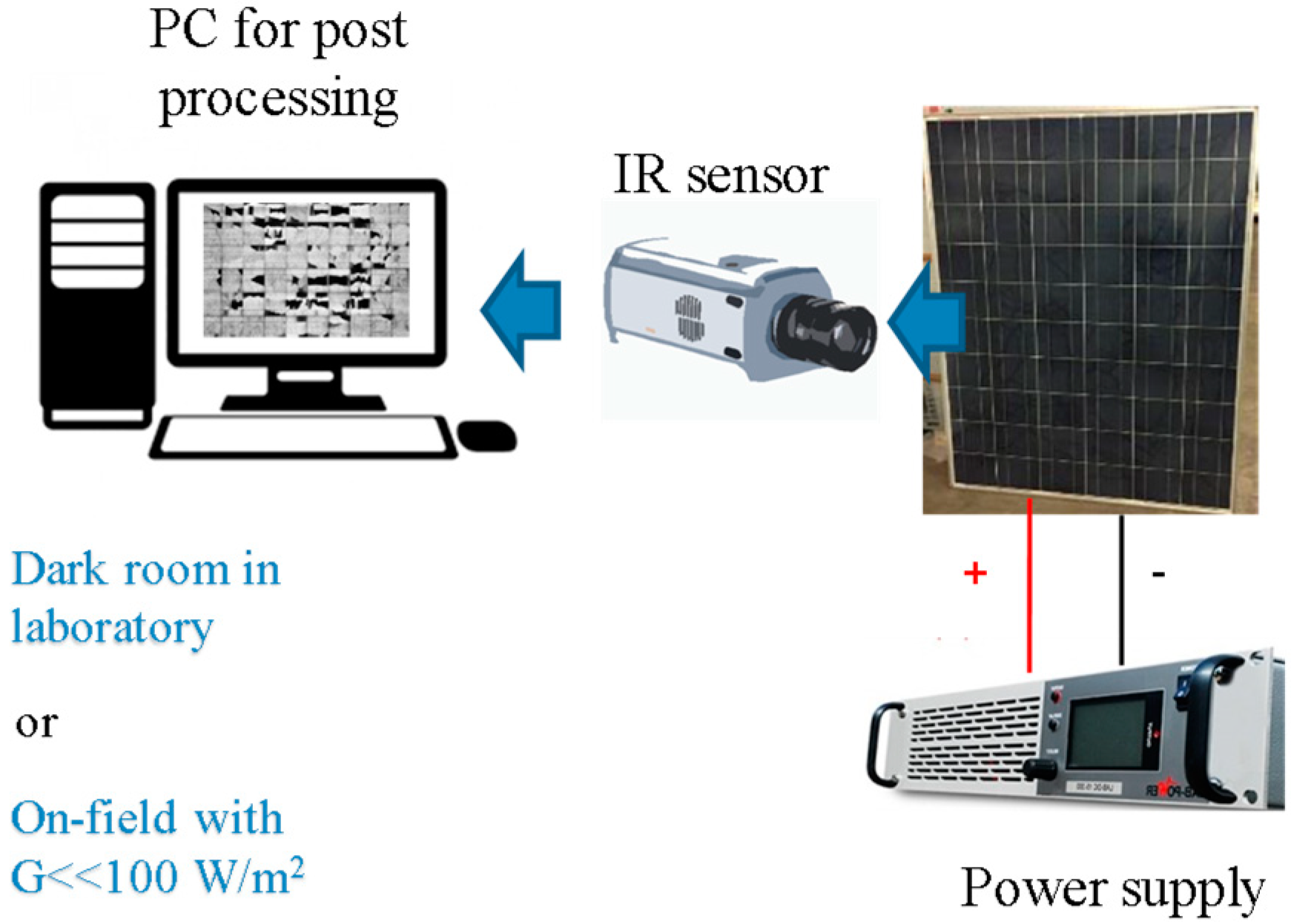
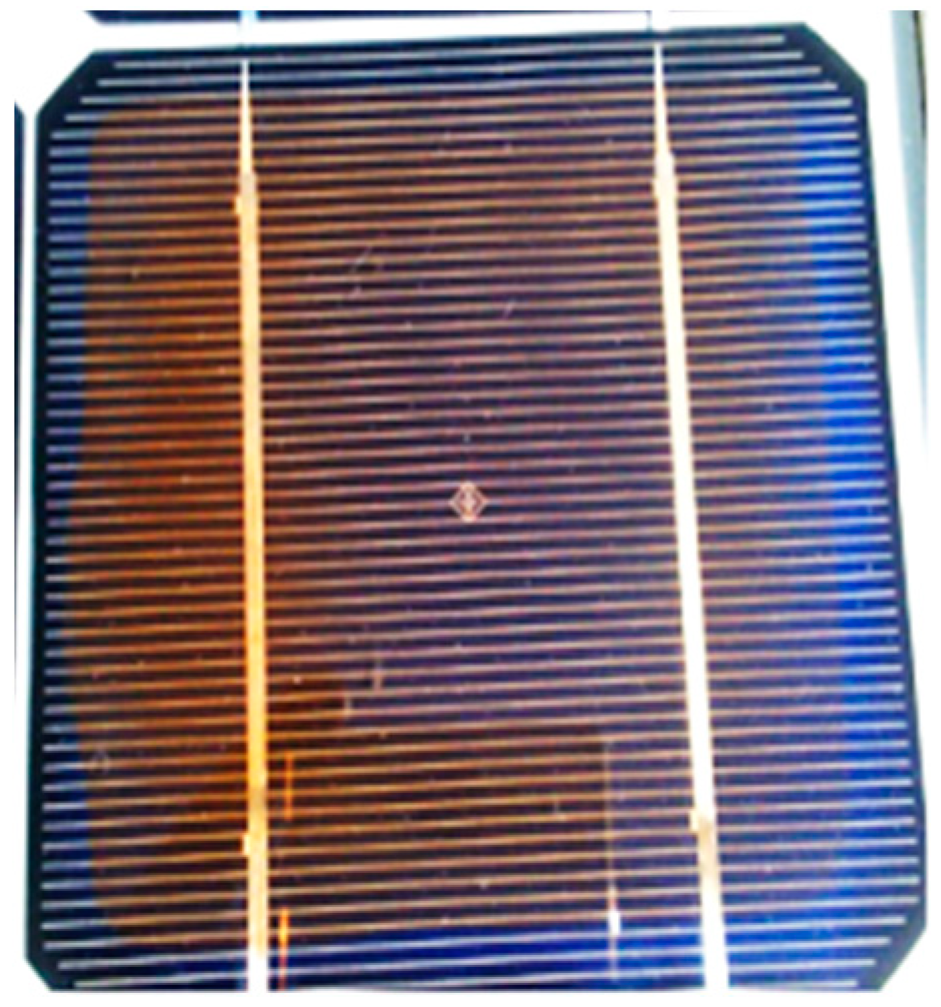
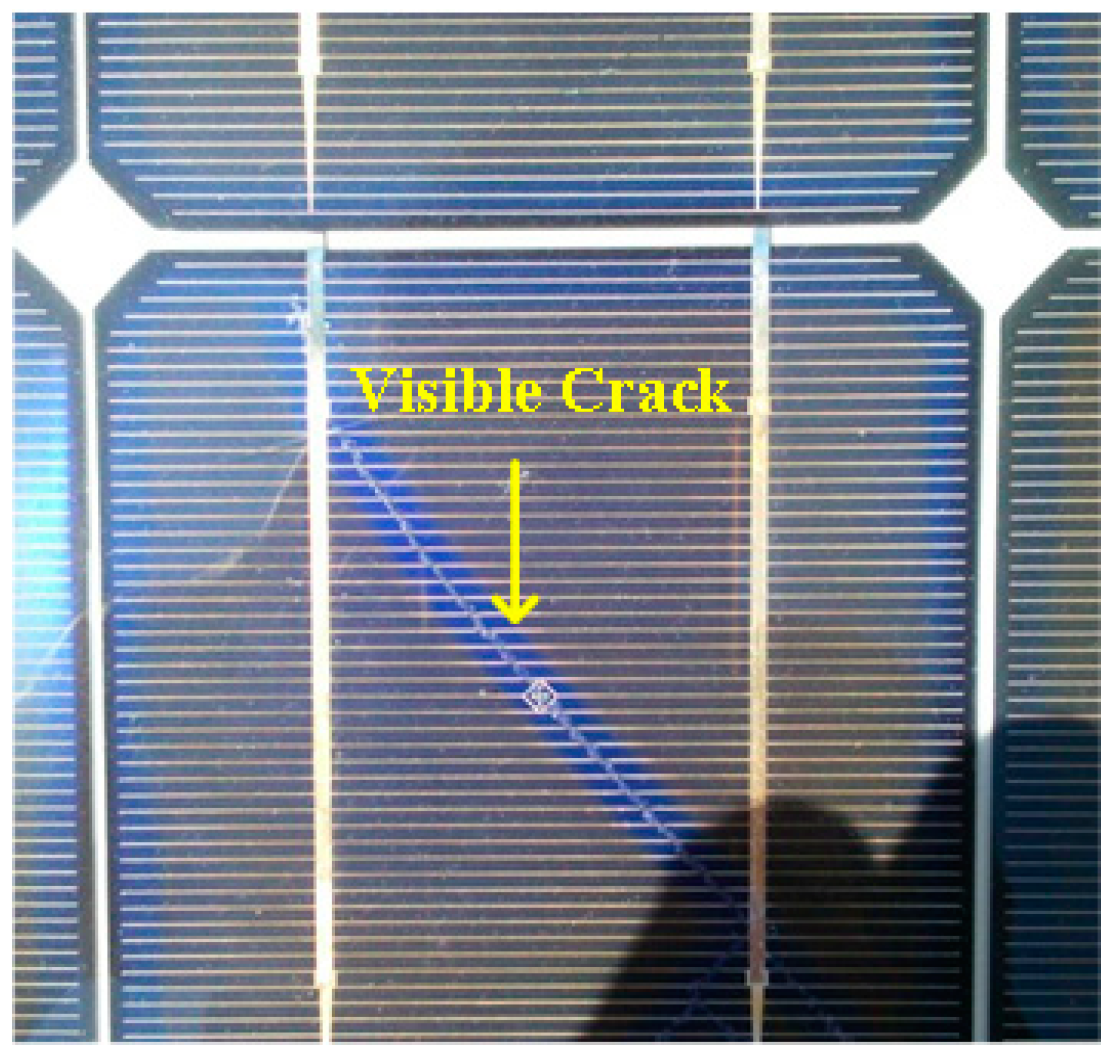
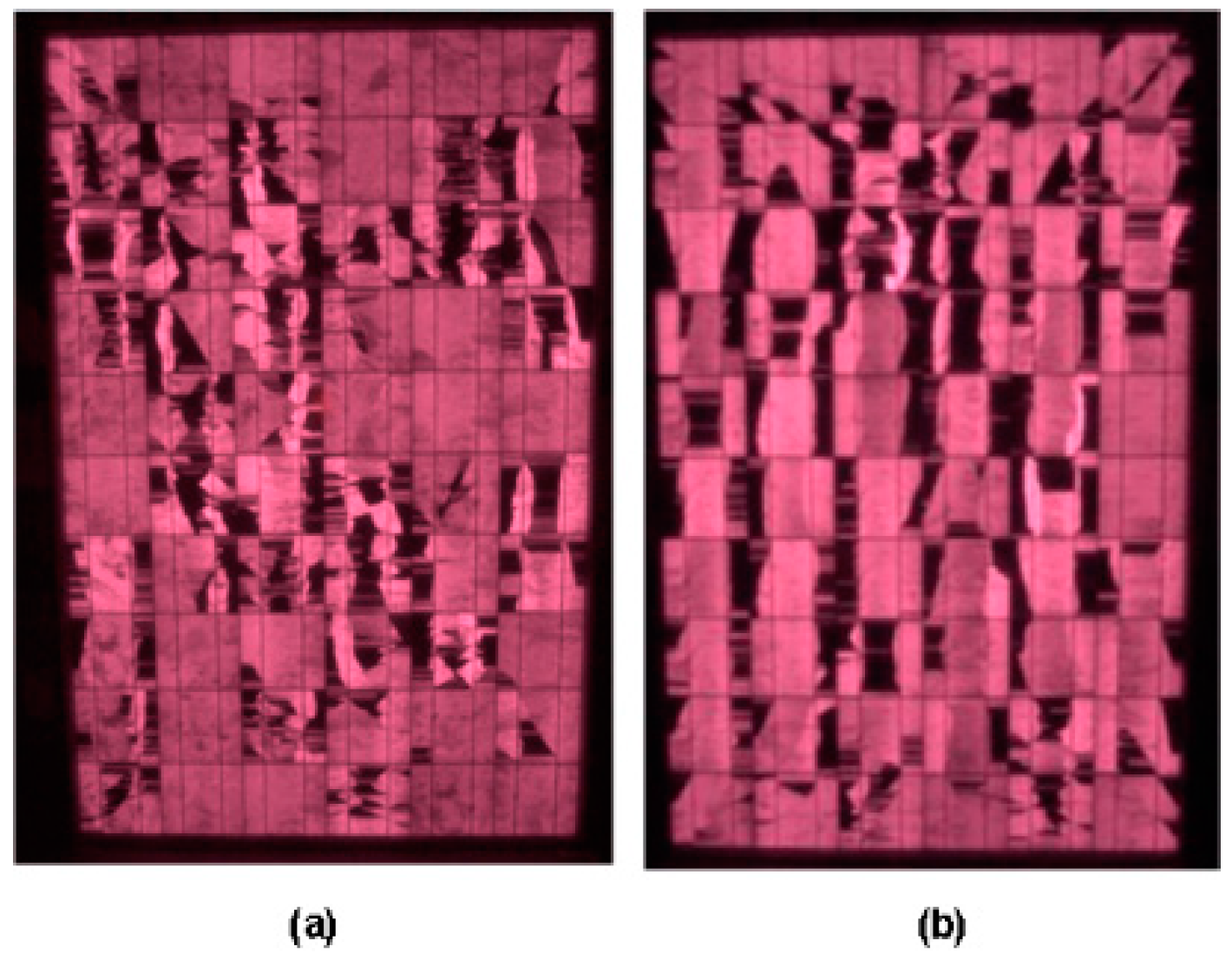


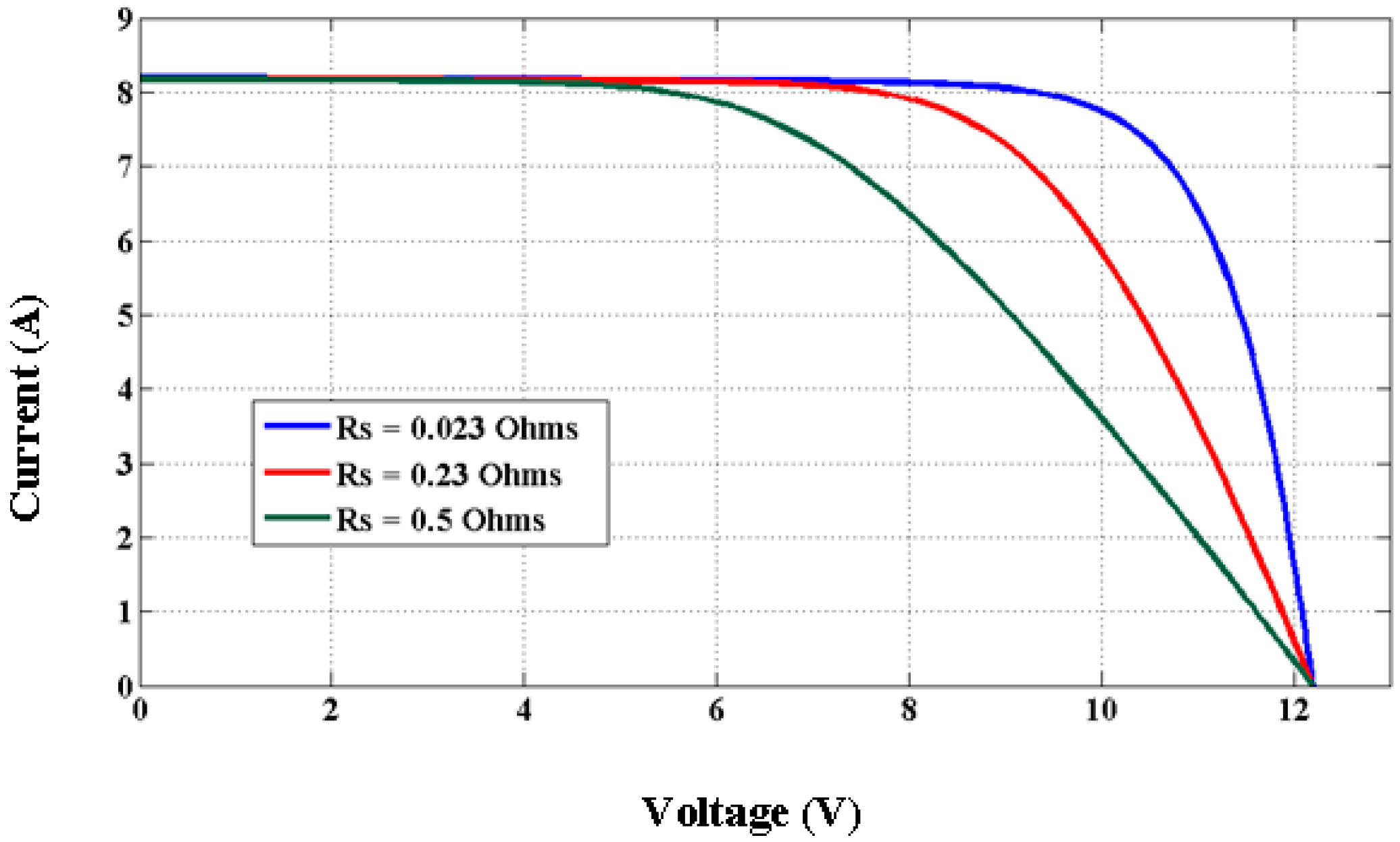
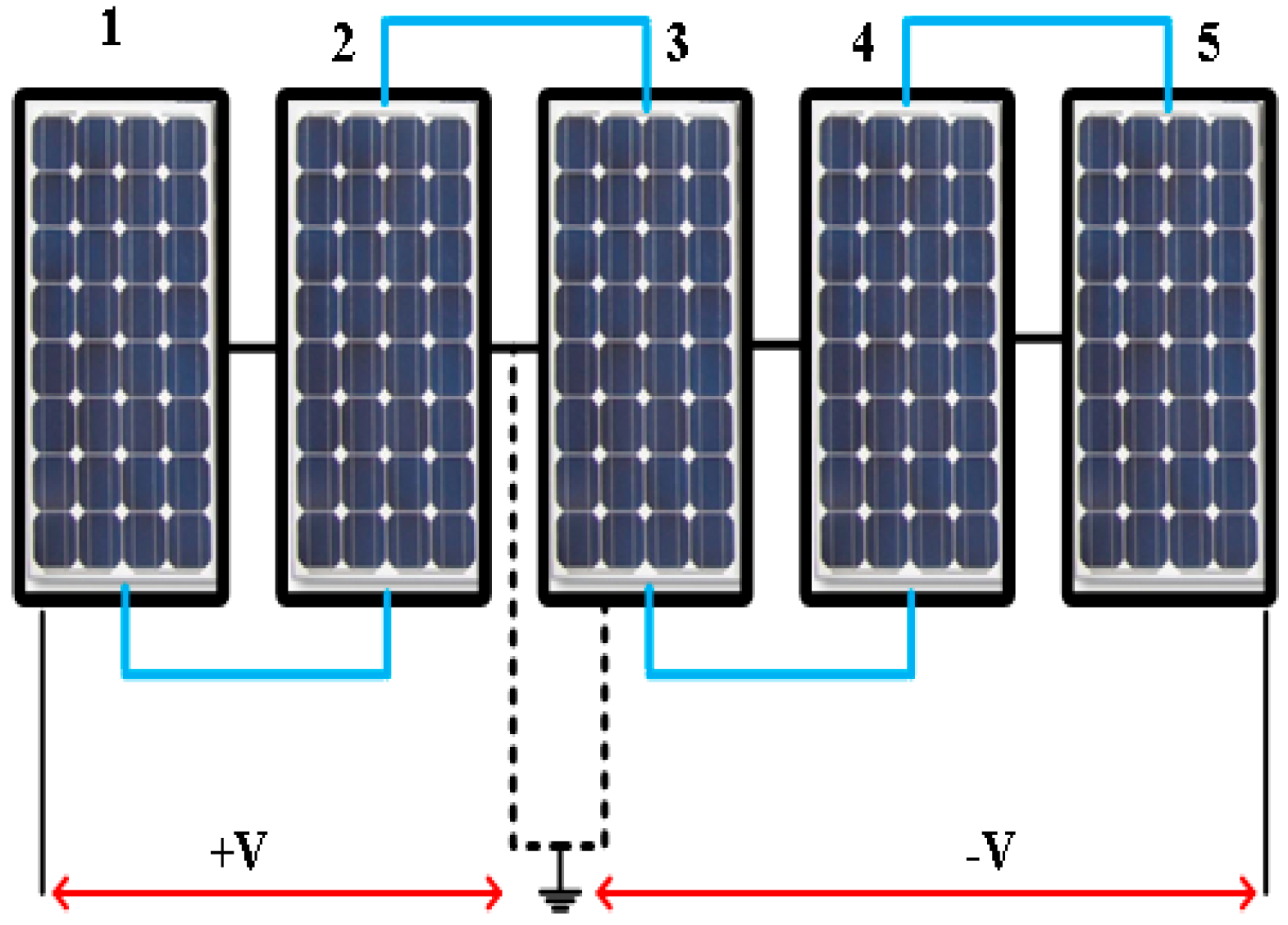
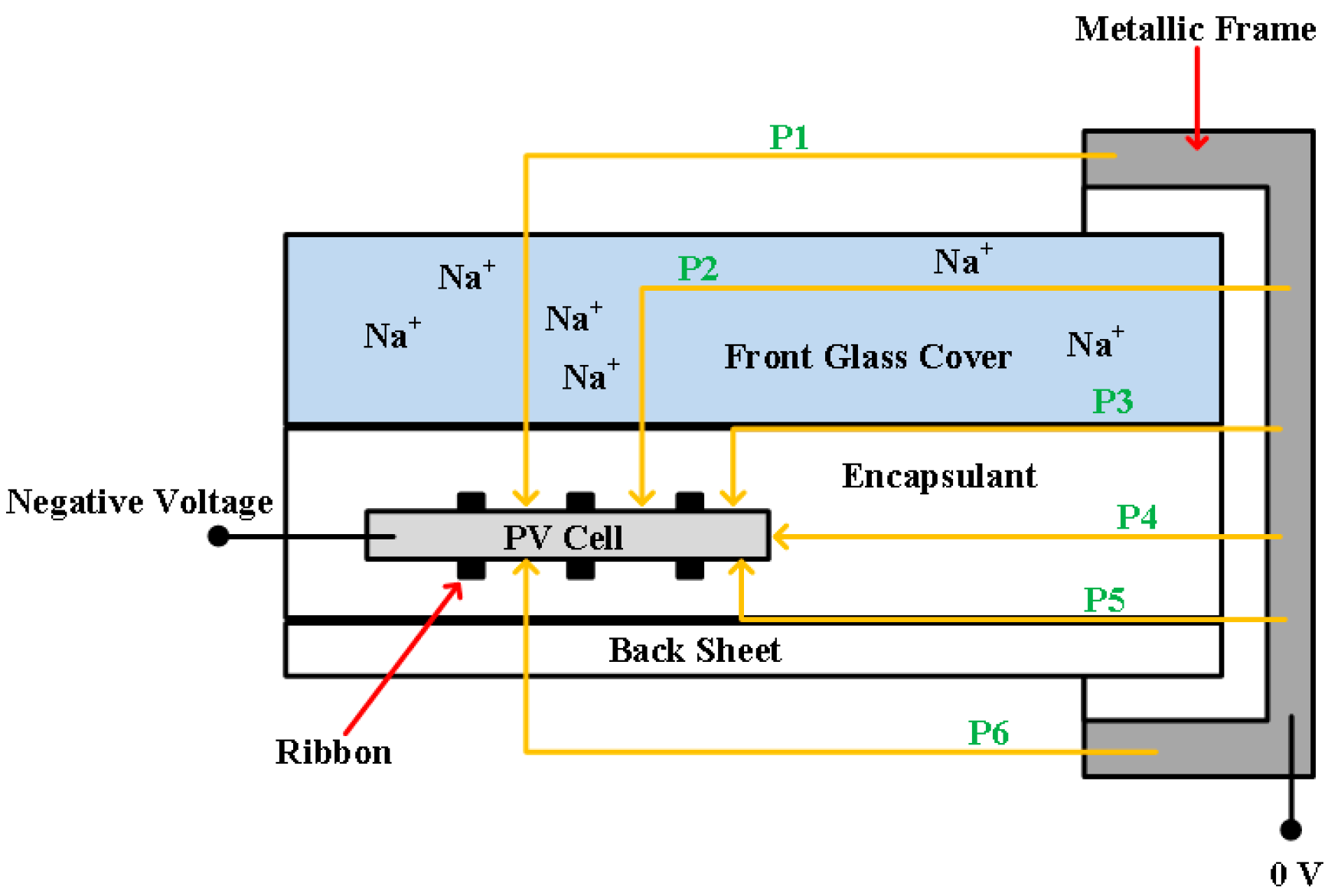
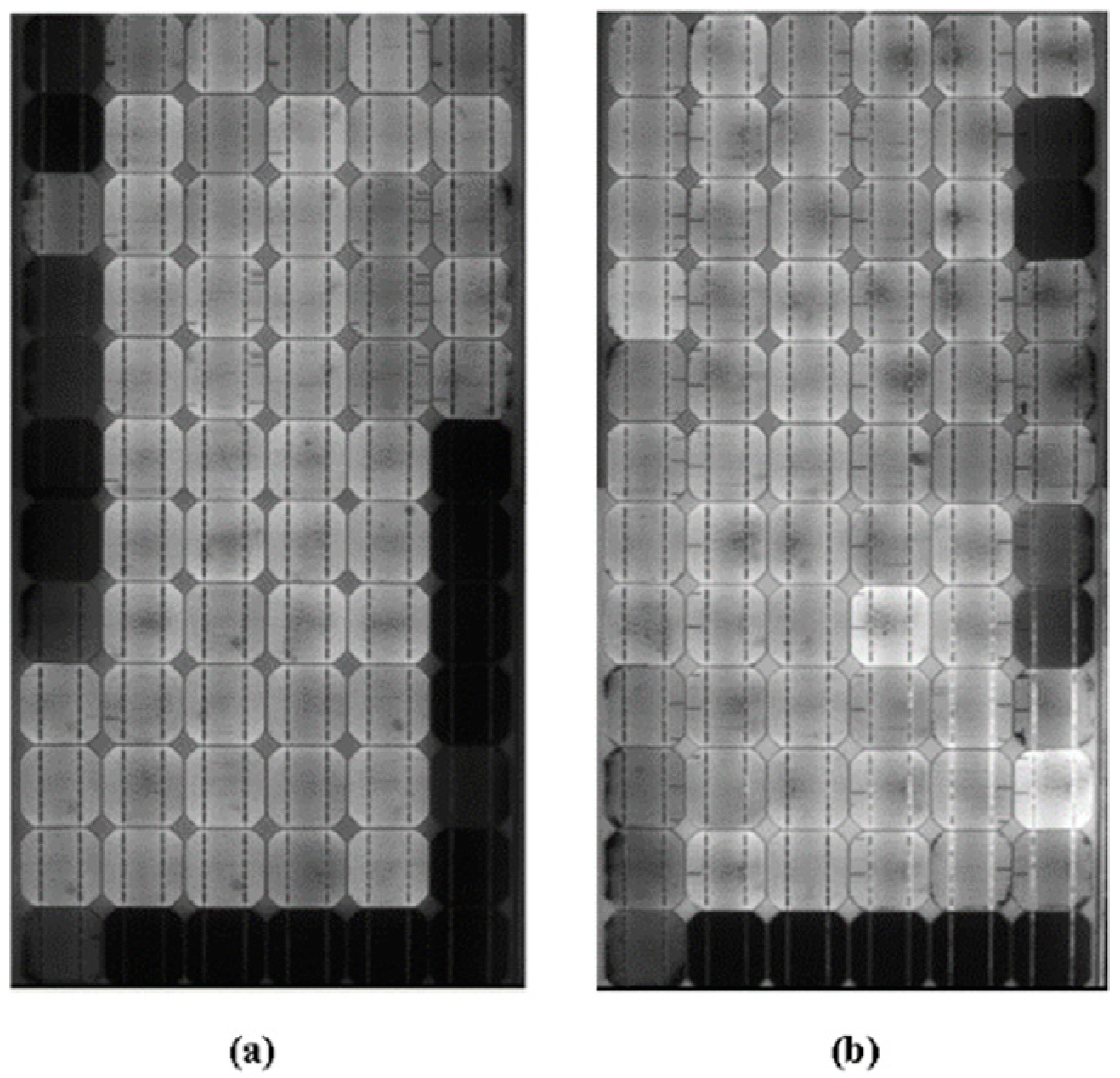
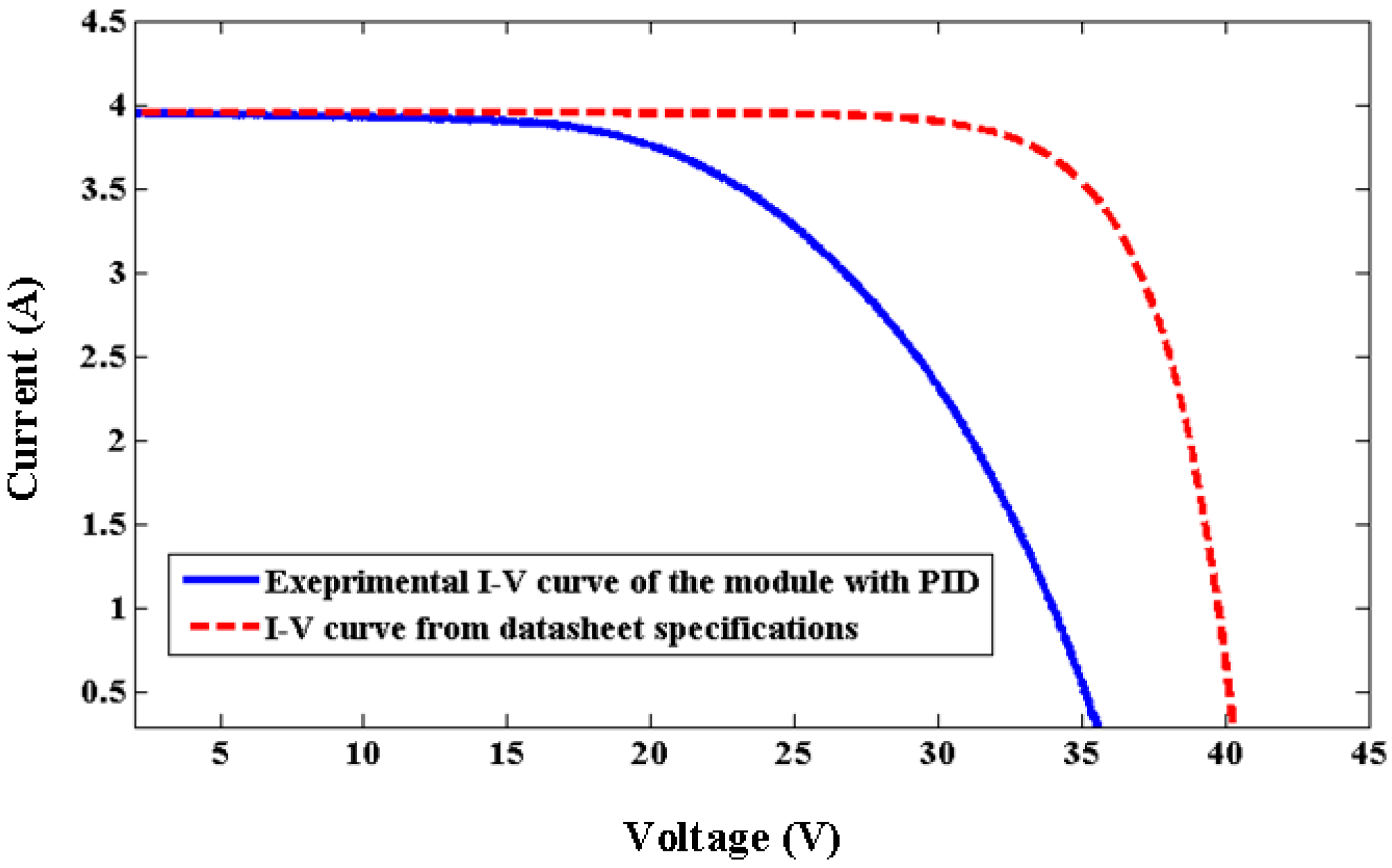
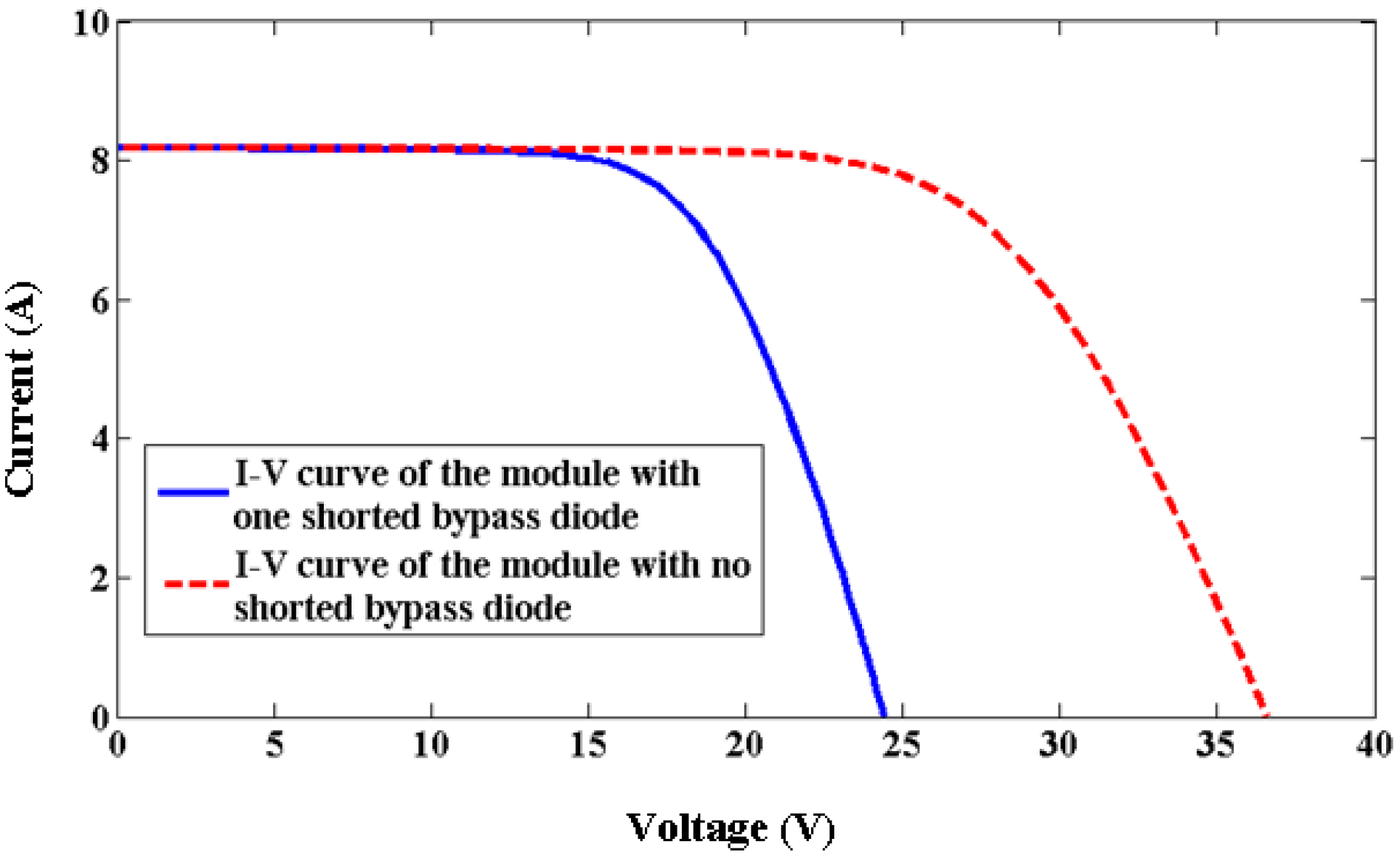
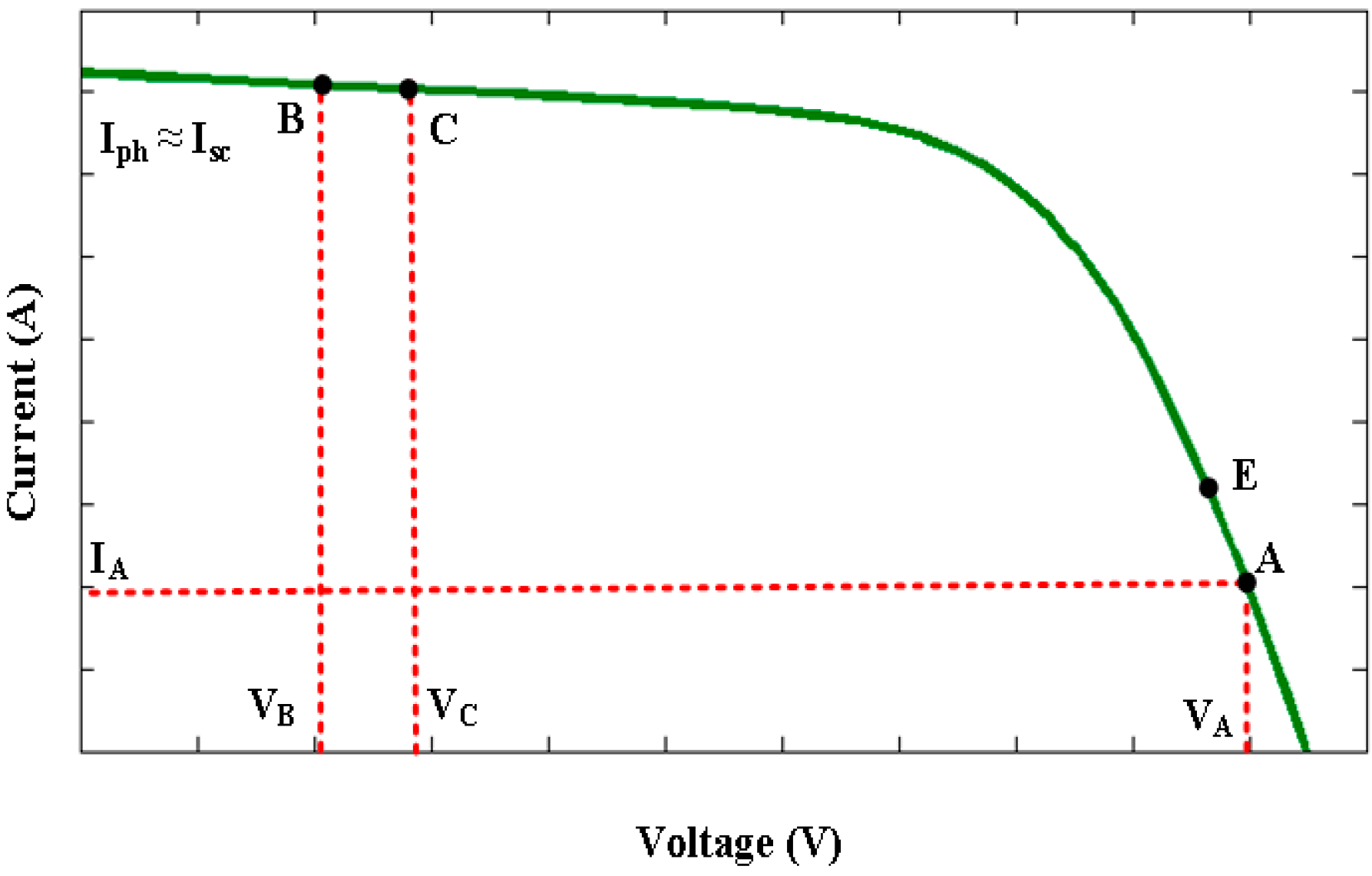
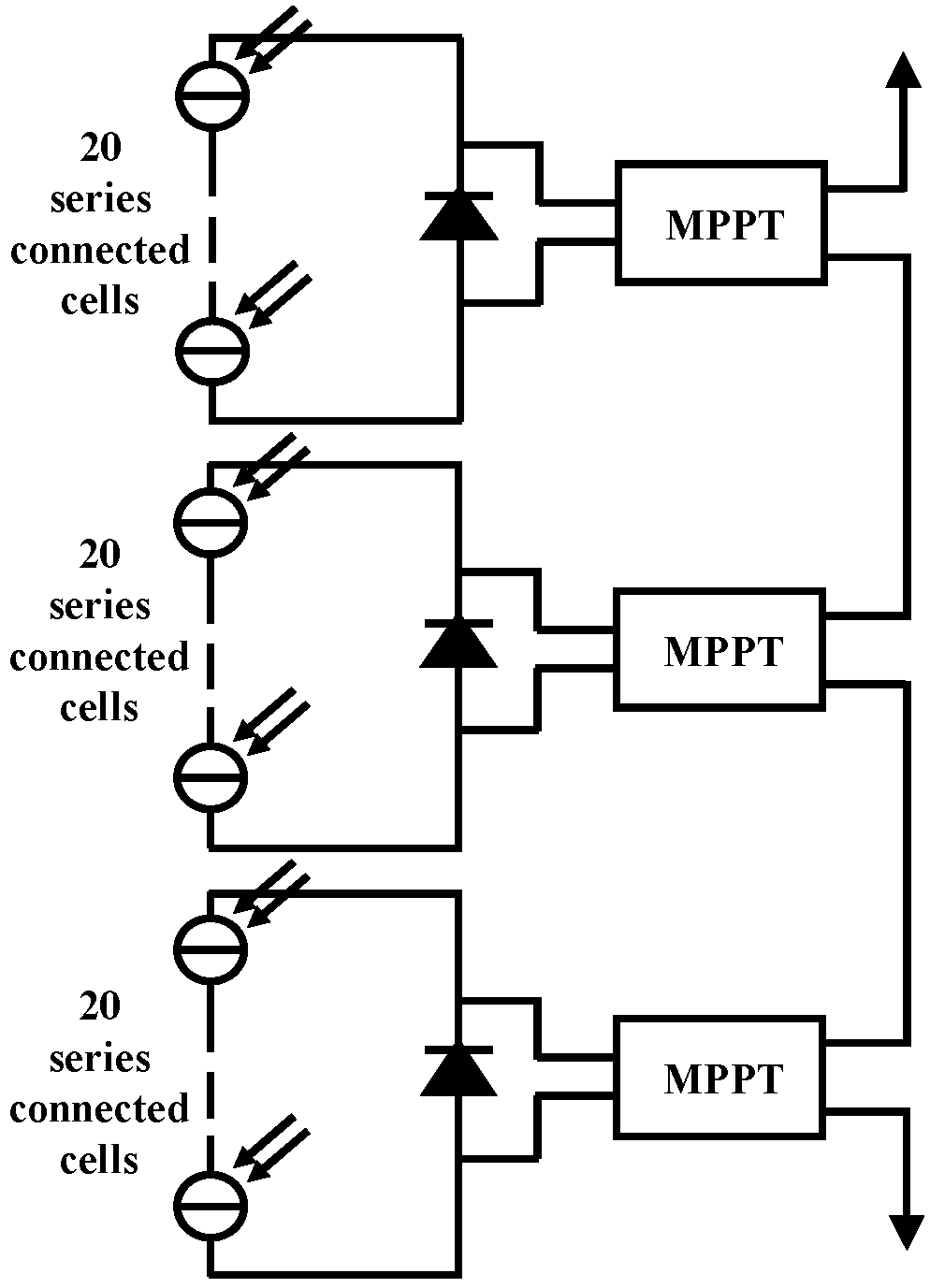
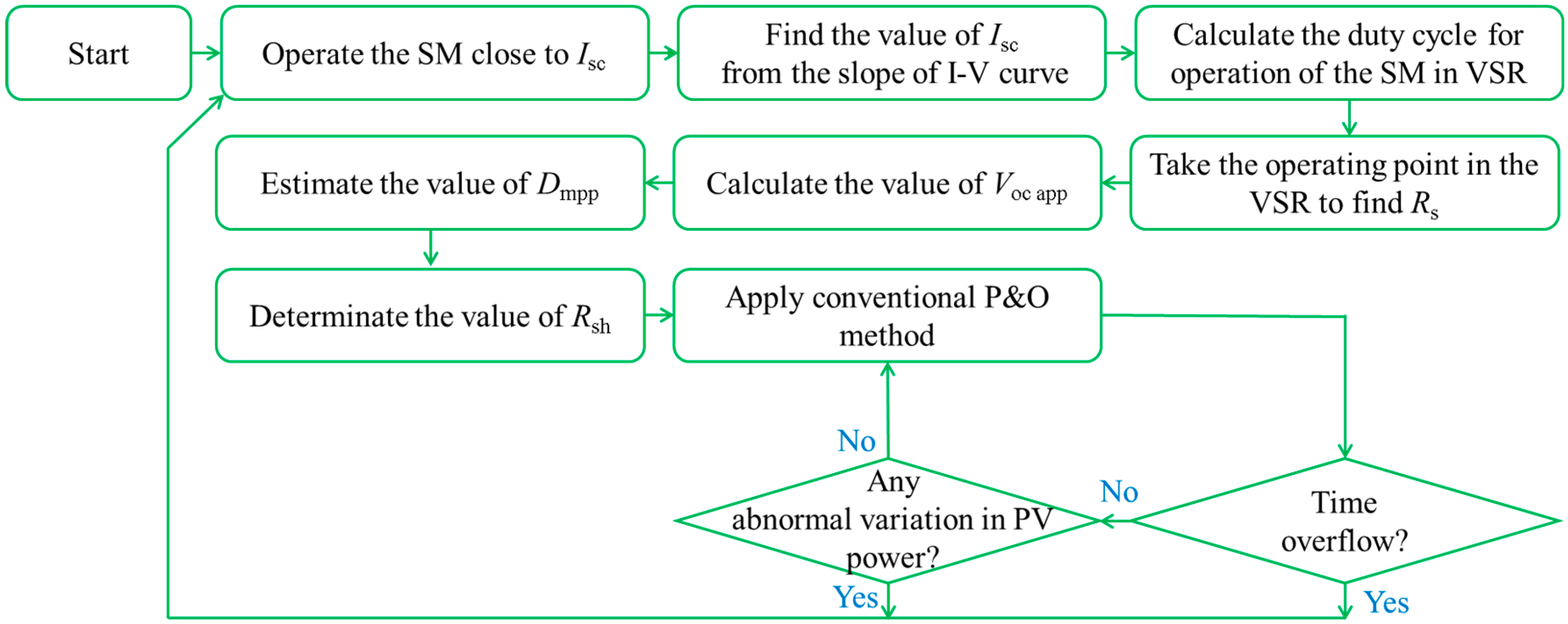
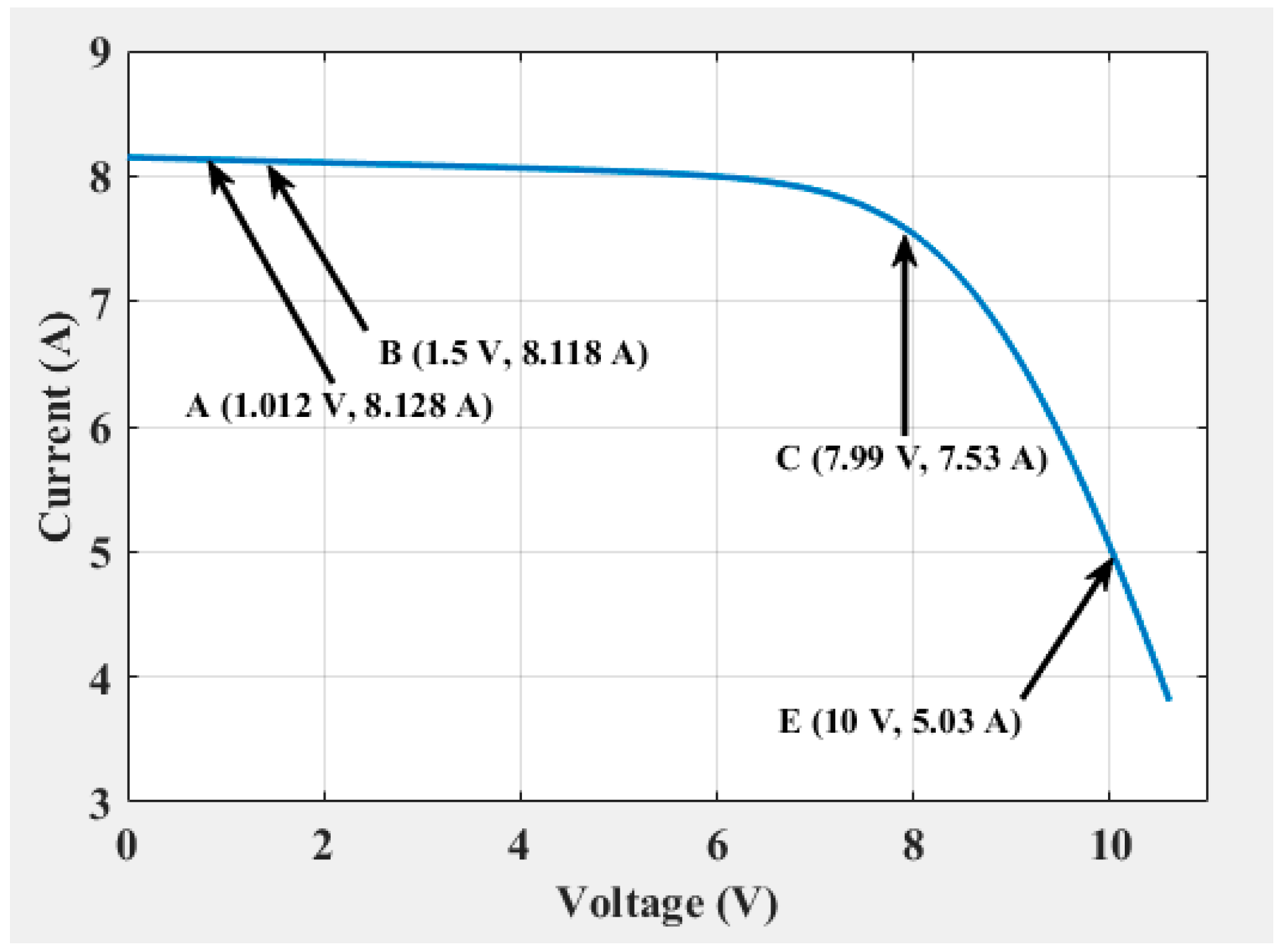
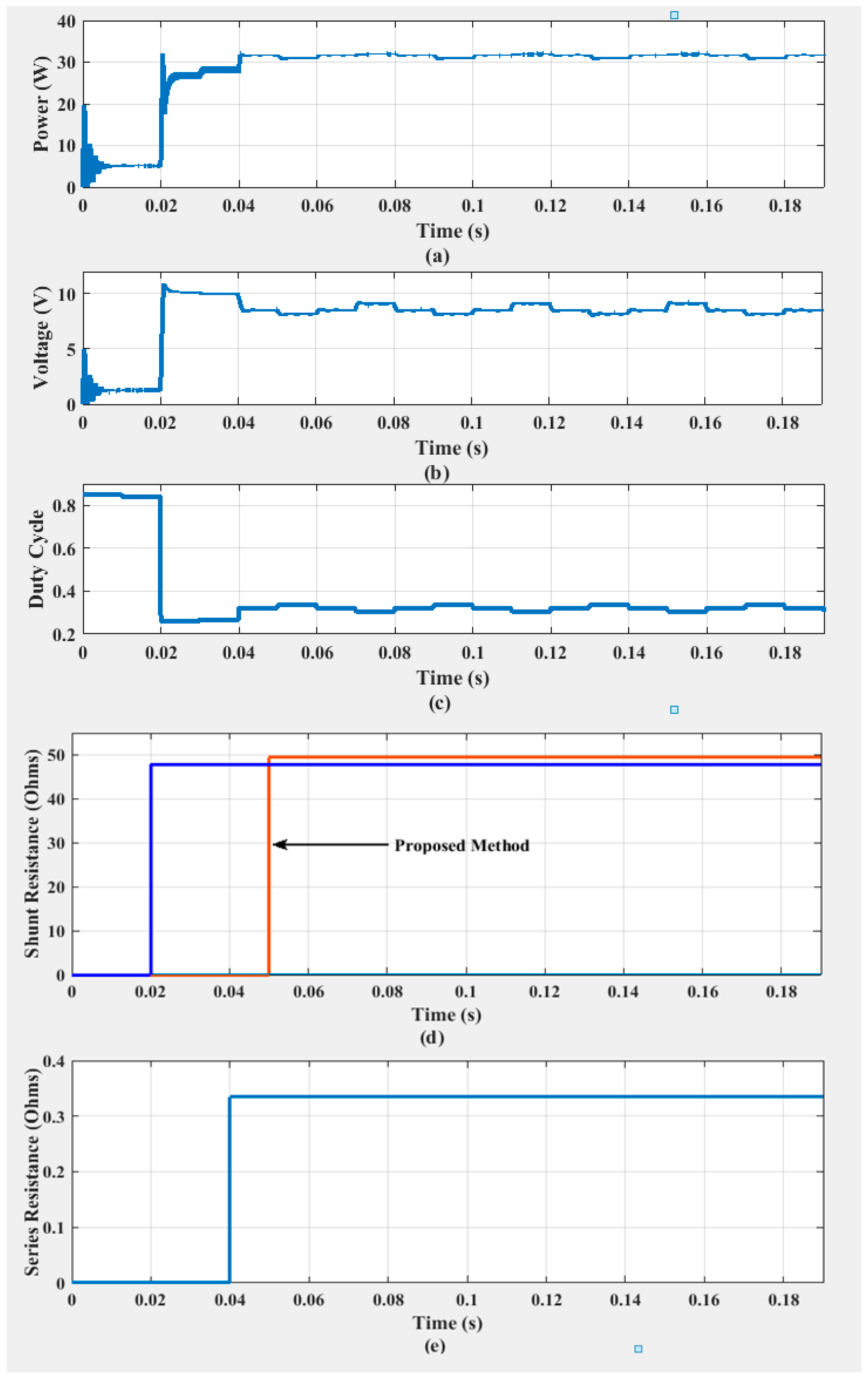
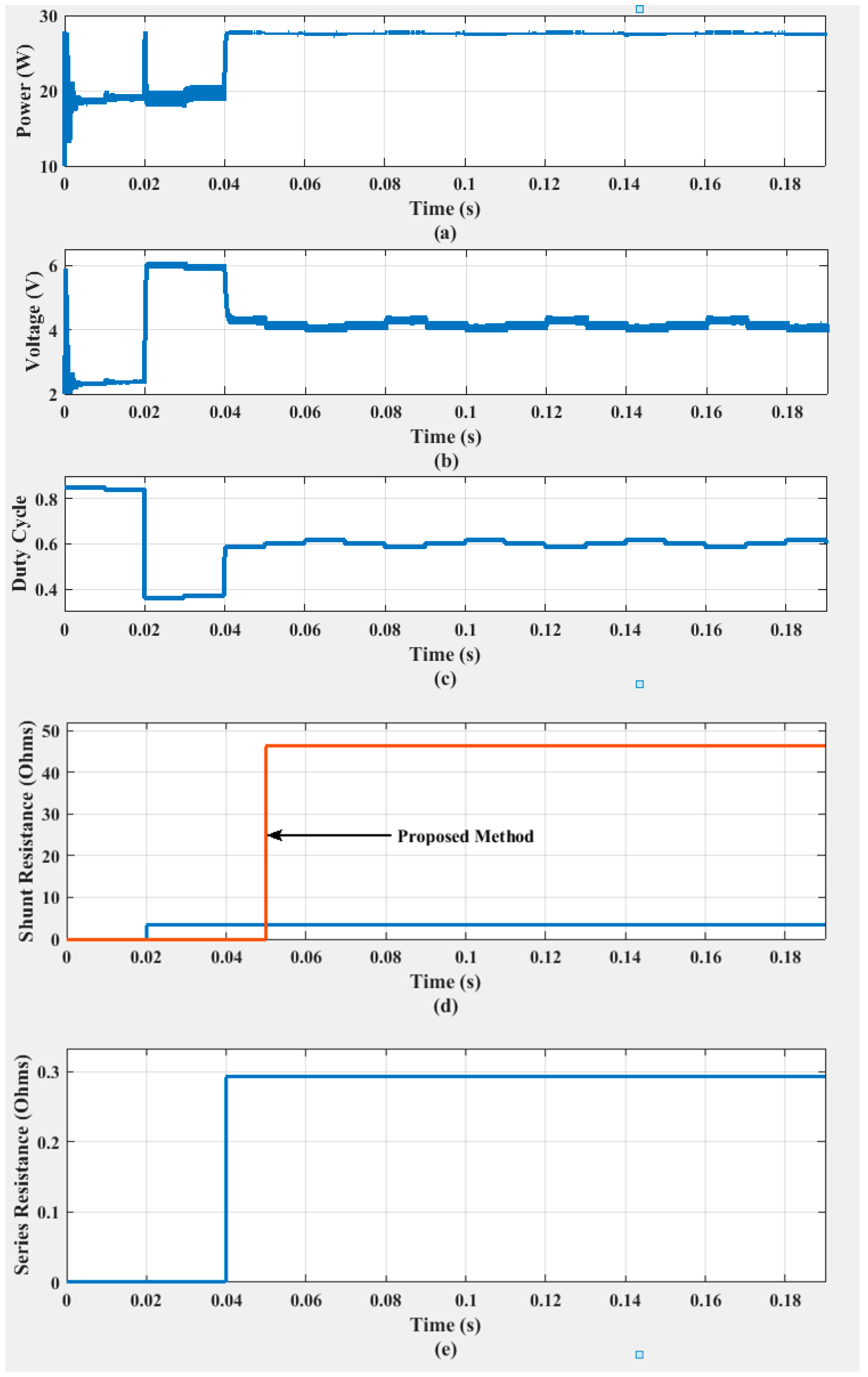
© 2019 by the authors. Licensee MDPI, Basel, Switzerland. This article is an open access article distributed under the terms and conditions of the Creative Commons Attribution (CC BY) license (http://creativecommons.org/licenses/by/4.0/).
Share and Cite
Ahmad, J.; Ciocia, A.; Fichera, S.; Murtaza, A.F.; Spertino, F. Detection of Typical Defects in Silicon Photovoltaic Modules and Application for Plants with Distributed MPPT Configuration. Energies 2019, 12, 4547. https://doi.org/10.3390/en12234547
Ahmad J, Ciocia A, Fichera S, Murtaza AF, Spertino F. Detection of Typical Defects in Silicon Photovoltaic Modules and Application for Plants with Distributed MPPT Configuration. Energies. 2019; 12(23):4547. https://doi.org/10.3390/en12234547
Chicago/Turabian StyleAhmad, Jawad, Alessandro Ciocia, Stefania Fichera, Ali Faisal Murtaza, and Filippo Spertino. 2019. "Detection of Typical Defects in Silicon Photovoltaic Modules and Application for Plants with Distributed MPPT Configuration" Energies 12, no. 23: 4547. https://doi.org/10.3390/en12234547
APA StyleAhmad, J., Ciocia, A., Fichera, S., Murtaza, A. F., & Spertino, F. (2019). Detection of Typical Defects in Silicon Photovoltaic Modules and Application for Plants with Distributed MPPT Configuration. Energies, 12(23), 4547. https://doi.org/10.3390/en12234547






